Triomel 9 G/L Nitrogen 1070 Kcal/L With Electrolytes Emulsion For Infusion
BE3001 755
Baxter
PACKAGE LEAFLET: INFORMATION FOR THE PATIENT
TRIOMEL 9 g/l nitrogen 1070 kcal/l with electrolytes, emulsion for infusion
Read all of this leaflet carefully before you will be administered this medicine because it contains important information for you.
• Keep this leaflet. You may need to read it again.
• If you have any further questions, ask your doctor or nurse.
• If you get any side effect, talk to your doctor or nurse. This includes any side effects not listed in this leaflet. See section 4.
What is in this leaflet:
1. What TRIOMEL 9 g/l nitrogen 1070 kcal/l with electrolytes, emulsion for infusion is and what it is used for
2. What you need to know before TRIOMEL 9 g/l nitrogen 1070 kcal/l with electrolytes, emulsion for infusion is administered
3. How TRIOMEL 9 g/l nitrogen 1070 kcal/l with electrolytes, emulsion for infusion will be used
4. Possible side effects
5. How TRIOMEL 9 g/l nitrogen 1070 kcal/l with electrolytes, emulsion for infusion is stored
6. Contents of the pack and other information
1. What TRIOMEL 9 g/l nitrogen 1070 kcal/l with electrolytes, emulsion for infusion is and what it is used for
TRIOMEL is an emulsion for infusion. It is presented in a bag with 3 chambers.
One chamber contains a glucose solution with calcium, the second one contains a lipid emulsion and the third one contains an amino acid solution with other electrolytes.
TRIOMEL is used to provide nutrition to adults and children greater than 2 years of age by a tube into a vein when normal feeding by mouth is not suitable.
TRIOMEL must only be used under medical supervision.
2. What you need to know before TRIOMEL 9 g/l nitrogen 1070 kcal/l with electrolytes, emulsion for infusion is administered
TRIOMEL 9 g/l nitrogen 1070 kcal/l with electrolytes, emulsion for infusion must not be used:
• In premature neonates, infants, and children less than 2 years old.
• If you are hypersensitive (allergic) to egg, soybean or peanut proteins or to any other ingredient.
• If your body has problems using certain amino acids.
• If you have an especially high level of fats in your blood.
• If you have hyperglycemia (too much sugar in your blood).
• If you have an abnormally high amount of any of the electrolytes (sodium, potassium, magnesium, calcium, and/or phosphorus) in your blood.
In all cases, your doctor will base his/her decision on whether you should receive this medicine on factors such as your age, weight, and medical condition, together with the results of any test performed.
Warnings and precautions
Talk to your doctor or nurse before TRIOMEL is administered to you.
If you are given total parenteral nutrition (TPN) solutions too fast this may result in injury or death.
The infusion must be stopped immediately if any abnormal signs or symptoms of an allergic reaction (such as sweating, fever, chills, headache, skin rashes, or difficulty breathing) develop. This medicinal product contains soybean oil and egg phosphatide. Soybean and egg proteins may cause hypersensitivity reactions. Cross-allergic reactions between soybean and peanut proteins have been observed.
Certain medications and illnesses can increase the risk of developing infection or sepsis (bacteria in the blood). There is a particular risk of infection or sepsis when a tube (intravenous catheter) is placed in your vein. Your doctor will carefully watch you for any signs of infection. Patients who require parenteral nutrition (giving nutrition through a tube in your vein) may be more likely to develop infections from their medical conditions. Using aseptic (“germ-free”) techniques when placing and caring for the catheter and when making the nutritional formula (TPN) can reduce the risk of infection.
If you are severely malnourished such that you need to receive feedings by vein, your doctor should start the treatment slowly. Also, your doctor should monitor you closely to prevent sudden changes in your fluid, vitamin, electrolyte and mineral levels.
The balance of water and salt in your body and metabolic disorders will be corrected before starting the infusion. Your doctor will monitor your condition while you receive this medicine and may change the dosage or give you additional nutrients, such as vitamins, electrolytes, and trace elements, if he/she feels they are appropriate.
Your doctor should be aware of:
• a severe kidney problem. You also must inform your doctor if you are on dialysis (artificial kidney) or if you have another form of blood cleaning treatment
• a severe liver problem
• a blood clotting problem
• adrenal glands that are not working properly (adrenal insufficiency). The adrenal glands are triangle-shaped glands located on top of your kidneys
• heart failure
• lung disease
• a build up of water in your body (hyperhydration)
• not enough water in your body (dehydration)
• high blood sugar (diabetes mellitus) that you are not being treated for
• a heart attack or shock due to a sudden heart failure
• a severe metabolic acidosis (when the blood is too acidic)
• a generalised infection (septicaemia)
• coma.
To check the effectiveness and ongoing safety of the administration, your doctor will perform clinical and laboratory tests while you are receiving this medicine. If you are given this medicine for several weeks, your blood will be monitored on a regular basis.
Reduced ability of the body to remove the fats contained in this medicine may result in a “fat overload syndrome” (See Section 4 - Possible Side Effects).
During the infusion if you notice pain, burning or swelling at the infusion site, or leakage of the infusion, tell your doctor or nurse. The administration will be stopped immediately and restarted in another vein.
If your blood sugar gets too high, your doctor should adjust the rate of TRIOMEL delivery or give you medication to control your blood sugar (insulin).
TRIOMEL may only be administered via a tube (catheter) into a large vein in your chest (central vein).
Children and adolescents
If your child is under 18 years old, special care will be taken to give him/her the correct dosage. Increased precautions will also be taken because of the greater sensitivity of children to the risk of infection. Vitamin and trace element supplementation is always required. Paediatric formulations must be used.
Other medicines and TRIOMEL
Tell your doctor if you are taking or using, have recently taken or used or might take or use any other medicines.
Simultaneous absorption of other medicinal products is not a contraindication, generally. If you take other medicinal products, with or without medical prescription, you should inform your doctor in advance to check compatibility.
TRIOMEL must not be administered simultaneously with blood through the same infusion tubing. TRIOMEL contains calcium. It should not be given together with the antibiotic ceftriaxone because particles may form.
The olive and soybean oils present in TRIOMEL contain vitamin K. This does not normally affect blood thinning medicines (anticoagulants) like coumarin. However, if you take anticoagulant medicines you should tell your doctor.
The lipids contained in this emulsion may interfere with the results of certain laboratory tests if the blood sample is taken before the lipids have been eliminated from your bloodstream (these are generally eliminated after a period of 5 to 6 hours without receiving lipids).
TRIOMEL contains potassium. Special care should be taken in patients taking diuretics, ACE inhibitors, angiotensin II receptor antagonists (drugs for high blood pressure), or immunosuppressants. These types of drugs may increase potassium levels in your blood.
Pregnancy, breast-feeding and fertility
If you are pregnant or breast-feeding, think you may be pregnant or are planning to have a baby, ask your doctor for advice before taking this medicine.
TRIOMEL may be considered during pregnancy and breastfeeding, if necessary.
3. How TRIOMEL 9 g/l nitrogen 1070 kcal/l with electrolytes, emulsion for infusion will be used
Dosage
TRIOMEL should only be given in adults and children greater than 2 years of age.
It is an emulsion for infusion, to be administered via a tube (catheter) into a vein in your chest.
TRIOMEL should be at room temperature before use.
TRIOMEL is for single use only.
The infusion of 1 bag usually lasts between 12 and 24 hours.
Dosage - Adults
Your doctor will specify a flow rate corresponding to your needs and clinical condition.
The prescription may be continued for as long as it is needed, depending upon your clinical condition.
Dosage - Children greater than two years of age and adolescents
The doctor will decide the dose and for how long the medication will be given. This will depend on age, weight, height, medical condition and the ability of the body to break down and use the ingredients in TRIOMEL.
If you have been administered more TRIOMEL 9 g/l nitrogen 1070 kcal/l with electrolytes, emulsion for infusion than you should
If the dose given is too high or the infusion is too fast, the amino acid content may make your blood too acidic, and signs of hypervolaemia (increase of circulating blood volume) may occur. The glucose levels in your blood and urine may increase, hyperosmolar syndrome (excessive blood viscosity) may develop, and the lipid content may increase the level of triglycerides in your blood. Receiving a volume of TRIOMEL that is too large may cause nausea, vomiting, chills and electrolyte disturbances. In such situations, the infusion must be stopped immediately.
In some severe cases, your doctor may have to give you temporary renal dialysis to help your kidneys eliminate the excess product.
To prevent these events occurring, your doctor will regularly monitor your condition and test your blood parameters.
If you have any further questions on the use of this product, ask your doctor.
4. Possible side effects
Like all medicines, this medicine can cause side effects, although not everybody gets them.
If you notice any changes in the way you feel during or after the treatment, tell your doctor or nurse right away.
The tests your doctor will perform while you are taking the medicine should minimise the risk of side effects.
If any abnormal signs or symptoms of an allergic reaction develop, such as sweating, fever, chills, headache, skin rashes, or breathing difficulties, the infusion should be stopped immediately.
The following side effects have been reported with TRIOMEL:
Frequency - Common: may affect up to 1 in 10 people
• Fast heart rate (tachycardia)
• Loss of appetite (anorexia)
• Increased level of fat in the blood (hypertriglyceridemia)
• Abdominal pain
• Diarrhoea
• Nausea
• Increased blood pressure (hypertension)
Frequency - Not known: frequency cannot be estimated from the available data
• Leakage of the infusion to the surrounding tissue (extravasation) which may result at infusion site level in pain, irritation, swelling/oedema, redness (erythema)/warmth, death of the tissue cells (skin necrosis) or blisters
The following side effects have been reported with similar parenteral nutrition products:
Frequency - Very rare: may affect up to 1 in 10000 people
• Reduced ability to remove the lipids (fat overload syndrome) associated with sudden and abrupt worsening of the patient’s medical condition. The following signs of fat overload syndrome are usually reversible when the lipid emulsion infusion is stopped:
- Fever
- Reduction in red blood cells which can make the skin pale and cause weakness or breathlessness (anaemia)
- Low white blood cell count, which can increase the risk of infection (leukopenia)
- Low platelet count which can increase the risk of bruising and/or bleeding (thrombocytopenia)
- Coagulation disorders which effect the ability of the blood to clot
- High levels of fats in the blood (hyperlipidaemia)
- Liver fatty infiltration (hepatomegaly)
- Worsening liver function
- Central nervous system manifestations (e.g. Coma).
Frequency - Not known: frequency cannot be estimated from the available data
• Allergic reactions
• Abnormal blood test results for liver function
• Problems with the elimination of bile (cholestasis)
• Increase in the size of the liver (hepatomegaly)
• Icterus (jaundice)
• Decrease in the number of platelets (thrombocytopenia)
• Increased nitrogen levels in the blood (azotemia) Elevated liver enzymes
Reporting of side effects
If you get any side effect, talk to your doctor or nurse. This includes any possible side effect not listed in this leaflet. You can also report side effects directly (see details below). By reporting side effects you can help provide more information on the safety of this medicine.
Malta
ADR Reporting The Medicines Authority Post-Licensing Directorate 203 Level 3, Rue D’Argens GZR-1368 Gzira
Website: www.medicinesauthority.gov.mt e-mail: postlicensing.medicinesauthority@gov.mt
Republic of Ireland:
FREEPOST,
Pharmacovigilance Section,
Irish Medicines Board,
Kevin O’Malley House,
Earlsfort Centre,
Earlsfort Terrace,
Dublin 2,
Ireland.
Tel: +353 1 6764971,
Fax: +353 1 6762517,
Website: www.imb.ie
e-mail: imbpharmacovigilance@imb.ie
United Kingdom:
Via the Yellow Card Scheme at: www.mhra.gov.uk/yellowcard
5. How TRIOMEL 9 g/l nitrogen 1070 kcal/l with electrolytes, emulsion for infusion is stored
Keep this medicine out of the sight and reach of children.
Do not use this medicine after the expiry date that is stated on the container and the outer packaging (MM/YYYY). The expiry date refers to the last day of that month.
Do not freeze.
Store in the overpouch.
Do not throw away medicines via wastewater or household waste. Ask your pharmacist how to throw away medicines you no longer use. These measures will help protect the environment.
6. Contents of the pack and other information
What TRIOMEL 9 g/l nitrogen 1070 kcal/l with electrolytes, emulsion for infusion contains
The active substances for each bag of the reconstituted emulsion are 14.2% (corresponding to 14.2 g/100 ml) L-amino acid solution (alanine, arginine, glycine, histidine, isoleucine, leucine, lysine (as lysine acetate), methionine, phenylalanine, proline, serine, threonine, tryptophan, tyrosine, valine, aspartic acid, glutamic acid) with electrolytes (sodium, potassium, magnesium, phosphate, acetate, chloride), 20% (corresponding to 20 g/100 ml) lipid emulsion (refined olive oil and refined soybean oil), and 27.5% (corresponding to 27.5 g/100 ml) glucose solution (as glucose monohydrate) with calcium.
The other ingredients are:
|
Lipid emulsion compartment |
Amino acid solution compartment |
Glucose solution compartment |
|
Purified egg phosphatide, glycerol, sodium oleate, sodium hydroxide (for pH adjustment), water for injection |
Glacial acetic acid (for pH adjustment), water for injection |
Hydrochloric acid (for pH adjustment), water for injection |
What TRIOMEL 9 g/l nitrogen 1070 kcal/l with electrolytes, emulsion for infusion looks like and contents of the pack
TRIOMEL is an emulsion for infusion packaged in a 3-compartment bag. One compartment contains a lipid emulsion, another compartment an amino acid solution with electrolytes and the third compartment a glucose solution with calcium. These compartments are separated by nonpermanent seals. Before administration, the content of the compartments need to be mixed by rolling the bag onto itself, starting at the top of the bag until the peal seal is open.
Appearance prior to reconstitution:
• The amino acid and glucose solutions are clear, colourless, or slightly yellow.
• The lipid emulsion is homogenous with a milky appearance.
Appearance after reconstitution: homogeneous milk-like emulsion.
The 3-compartment bag is a multilayer plastic bag. The inner (contact) layer of the bag material is designed to be compatible with the constituents and authorised additives.
To prevent contact with oxygen contained in the air, the bag is packaged in an oxygen barrier overpouch with an oxygen absorber sachet that may include an oxygen indicator (OXYDETECT).
Pack sizes
1000 ml bag: 1 carton with 6 bags 1500 ml bag: 1 carton with 4 bags 2000 ml bag: 1 carton with 4 bags 1 bag of 1000 ml, 1500 ml and 2000 ml Not all pack sizes may be marketed.
Marketing Authorisation Holder
Baxter Healthcare Limited
Caxton Way, Thetford,
Norfolk, IP24 3SE United Kingdom
Manufacturer
BAXTER S.A.
BOULEVARD RENE BRANQUART, 80
7860 LESSINES
BELGIUM
This medicinal product is authorised in the Member States of the EEA under the following names: France, Portugal, Estonia, Poland, Lithuania, Bulgaria, Romania,
Latvia, Czech Republic, Belgium, Spain, Slovak Republic,
The Netherlands, Luxemburg, Slovenia, Italy, Greece: OLIMEL N9E
In some countries it is registered under a different trade name, as described below:
Austria: ZentroOLIMEL 5,7 % mit Elektrolyten
Germany: Olimel 5,7% E
Denmark, Iceland, Sweden, Norway, Finland: Olimel N9E
The United Kingdom, Ireland, Malta: Triomel 9g/l nitrogen 1070 kcal/l
with electrolytes
Hungary: Olimel 9 g/l nitrogen elektrolitokkal
emulzios infuzio
This leaflet was last revised in 04/2014.
For information about TRIOMEL or to request this leaflet in formats such as audio or large print please contact the Marketing Authorisation Holder: Tel: +44 (0)1635 206345
Baxter, Triomel and Oxydetect are trademarks of Baxter international Inc.
The following information is intended for medical or healthcare professionals only:
TRIOMEL 9 g/l nitrogen 1070 kcal/l with electrolytes, emulsion for infusion
Pharmacotherapeutic group: Solutions for parenteral nutrition/combinations ATC code: B05 BA10.
A. QUALITATIVE AND QUANTITATIVE COMPOSITION
TRIOMEL is presented in the form of a 3-compartment bag.
Each bag contains a glucose solution with calcium, a lipid emulsion and an amino acid solution with other electrolytes.
|
Contents per bag | |||
|
1000 ml |
1500 ml |
2000 ml | |
|
27.5% Glucose solution (corresponding to 27.5 g/100 ml) |
400 ml |
600 ml |
800 ml |
|
14.2% Amino acid solution (corresponding to 14.2 g/100 ml) |
400 ml |
600 ml |
800 ml |
|
20% Lipid emulsion (corresponding to 20 g/100 ml) |
200 ml |
300 ml |
400 ml |
Composition of the reconstituted emulsion after mixing the contents of the 3 compartments:
|
Active substances |
1000 ml |
1500 ml |
2000 ml |
|
Refined olive oil + refined soybean oila |
40.00 g |
60.00 g |
80.00 g |
|
Alanine |
8.24 g |
12.36 g |
16.48 g |
|
Arginine |
5.58 g |
8.37 g |
11.16 g |
|
Aspartic acid |
1.65 g |
2.47 g |
3.30 g |
|
Glutamic acid |
2.84 g |
4.27 g |
5.69 g |
|
Glycine |
3.95 g |
5.92 g |
7.90 g |
|
Histidine |
3.40 g |
5.09 g |
6.79 g |
|
Isoleucine |
2.84 g |
4.27 g |
5.69 g |
|
Leucine |
3.95 g |
5.92 g |
7.90 g |
|
Lysine |
4.48 g |
6.72 g |
8.96 g |
|
(equivalent to lysine acetate) |
(6.32 g) |
(9.48 g) |
(12.64 g) |
|
Methionine |
2.84 g |
4.27 g |
5.69 g |
|
Phenylalanine |
3.95 g |
5.92 g |
7.90 g |
|
Proline |
3.40 g |
5.09 g |
6.79 g |
|
Serine |
2.25 g |
3.37 g |
4.50 g |
|
Threonine |
2.84 g |
4.27 g |
5.69 g |
|
Tryptophan |
0.95 g |
1.42 g |
1.90 g |
|
Tyrosine |
0.15 g |
0.22 g |
0.30 g |
|
Valine |
3.64 g |
5.47 g |
7.29 g |
|
Sodium acetate, trihydrate |
1.50 g |
2.24 g |
2.99 g |
|
Sodium glycerophosphate, hydrated |
3.67 g |
5.51 g |
7.34 g |
|
Potassium chloride |
2.24 g |
3.35 g |
4.47 g |
|
Magnesium chloride, hexahydrate |
0.81 g |
1.22 g |
1.62 g |
|
Calcium chloride, dihydrate |
0.52 g |
0.77 g |
1.03 g |
|
Glucose anhydrous |
110.00 g |
165.00 g |
220.00 g |
|
(equivalent to glucose monohydrate) |
(121.00 g) |
(181.50 g) |
(242.00 g) |
a: Mixture of refined olive oil (approximately 80%) and refined soybean oil (approximately 20%) corresponding to a ratio essential fatty acids/total fatty acids of 20%.
The excipients are:
|
Lipid emulsion compartment |
Amino acid solution with electrolytes compartment |
Glucose solution with calcium compartment |
|
Purified egg phosphatide, glycerol, sodium oleate, sodium hydroxide (for pH adjustment), water for injection |
Glacial acetic acid (for pH adjustment), water for injection |
Hydrochloric acid (for pH adjustment), water for injection |
Nutritional intakes of reconstituted emulsion for each of the bag sizes:
|
1000 ml |
1500 ml |
2000 ml | |
|
Lipids |
40 g |
60 g |
80 g |
|
Amino acids |
56.9 g |
85.4 g |
113.9 g |
|
Nitrogen |
9.0 g |
13.5 g |
18.0 g |
|
Glucose |
110.0 g |
165.0 g |
220.0 g |
|
Energy: | |||
|
Total calories approx. |
1070 kcal |
1600 kcal |
2140 kcal |
|
Non-protein calories |
840 kcal |
1260 kcal |
1680 kcal |
|
Glucose calories |
440 kcal |
660 kcal |
880 kcal |
|
Lipid caloriesa |
400 kcal |
600 kcal |
800 kcal |
|
Non-protein calories/nitrogen ratio |
93 kcal/g |
93 kcal/g |
93 kcal/g |
|
Glucose/lipid calories ratio |
52/48 |
52/48 |
52/48 |
|
Lipid/total calories |
37% |
37% |
37% |
|
Electrolytes: | |||
|
Sodium |
35.0 mmol |
52.5 mmol |
70.0 mmol |
|
Potassium |
30.0 mmol |
45.0 mmol |
60.0 mmol |
|
Magnesium |
4.0 mmol |
6.0 mmol |
8.0 mmol |
|
Calcium |
3.5 mmol |
5.3 mmol |
7.0 mmol |
|
Phosphateb |
15.0 mmol |
22.5 mmol |
30.0 mmol |
|
Acetate |
54 mmol |
80 mmol |
107 mmol |
|
Chloride |
45 mmol |
68 mmol |
90 mmol |
|
pH |
6.4 |
6.4 |
6.4 |
|
Osmolarity |
1310 mosm/l |
1310 mosm/l |
1310 mosm/l |
a: Includes calories from purified egg phosphatide b: Includes phosphate provided by the lipid emulsion
B. POSOLOGY AND METHOD OF ADMINISTRATION
Posology
TRIOMEL is not recommended for use in children less than 2 years of age due to inadequate composition and volume (see sections 4.4; 5.1 and 5.2 of the SmPC).
In adults
The dosage depends on the patient’s energy expenditure, clinical status, body weight, and the ability to metabolise the constituents of TRIOMEL, as well as additional energy or proteins provided orally/enterally; therefore, the bag size should be chosen accordingly.
The average daily requirements are:
- 0.16 to 0.35 g nitrogen/kg body weight (1 to 2 g of amino acids/kg), depending on the patient’s nutritional status and degree of catabolic stress,
- 20 to 40 kcal/kg,
- 20 to 40 ml fluid/kg, or 1 to 1.5 ml per expended kcal.
For TRIOMEL, the maximal daily dose is defined by amino acids intake, 35 ml/kg corresponding to 2.0 g/kg amino acids, 3.9 g/kg glucose, 1.4 g/kg lipids, 1.2 mmol/kg sodium, and 1.1 mmol/kg potassium. For a 70 kg patient, this would be equivalent to 2450 ml TRIOMEL per day, resulting in an intake of 140 g amino acids, 270 g glucose, and 98 g lipids (i.e., 2058 non-protein kcal and 2622 total kcal).
Normally, the flow rate must be increased gradually during the first hour and then be adjusted to take into account the dose being administered, the daily volume intake, and the duration of the infusion.
For TRIOMEL, the maximal infusion rate is 1.8 ml/kg/hour, corresponding to 0.10 g/kg/hour amino acids, 0.19 g/kg/hour glucose, and 0.07 g/kg/hour lipids.
In children greater than 2 years of age
There have been no studies performed in the paediatric population.
The dosage depends on the patient’s energy expenditure, clinical status, body weight, and the ability to metabolise constituents of TRIOMEL, as well as additional energy or proteins given orally/enterally; therefore, the bag size should be chosen accordingly.
In addition, daily fluid, nitrogen, and energy requirements continuously decrease with age. Two groups, ages 2 to 11 years and 12 to 18 years, are considered.
For TRIOMEL in the 2 to 11 year age group, the limiting factors are phosphate concentration for daily dose (0.2 mmol/kg/day)a and lipid concentration for hourly rate. In the 12 to 18 year age group, the limiting factors are phosphate concentration for daily dose (0.2 mmol/kg/day)a and amino acid concentration for hourly rate. The resulting intakes are displayed below:
|
Constituent |
2 to 11 years |
12 to 18 years | ||
|
Recommendeda |
TRIOMEL Max Vol |
Recommendeda |
TRIOMEL Max Vol | |
|
Maximum Daily Dose | ||||
|
Fluids (ml/kg/d) |
60 - 120 |
13 |
50 - 80 |
13 |
|
Amino acids (g/kg/d) |
1 - 2 (up to 3) |
0.8 |
1 - 2 |
0.8 |
|
Glucose (g/kg/d) |
12 - 14 (up to 18) |
1.5 |
3 - 10 (up to 14) |
1.5 |
|
Lipids (g/kg/d) |
0.5 - 3 |
0.5 |
0.5 - 2 (up to 3) |
0.5 |
|
Total energy (kcal/kg/d) |
60 - 90 |
14 |
30 - 75 |
14 |
|
Maximum Hourly Rate | ||||
|
TRIOMEL (ml/kg/h) |
3.3 |
2.1 | ||
|
Amino acids (g/kg/h) |
0.20 |
0.19 |
0.12 |
0.12 |
|
Glucose (g/kg/h) |
1.2 |
0.36 |
1.2 |
0.23 |
|
Lipids (g/kg/h) |
0.13 |
0.13 |
0.13 |
0.08 |
a: Recommended values from 2005 ESPGHAN/ESPEN Guidelines
Normally, the flow rate must be increased gradually during the first hour and then be adjusted to take into account the dose being administered, the daily volume intake, and the duration of the infusion.
In general, it is recommended to start the infusion for small children with low daily dose and gradually increase it up to the maximal dosage (see above).
Method and duration of administration
For single use only.
It is recommended that, after opening the bag, the contents are used immediately and not stored for subsequent infusion.
After reconstitution, the mixture is homogenous with a milky appearance.
For instructions for preparation and handling of the emulsion for infusion, see section 6.6 of the SmPC. Due to its high osmolarity, TRIOMEL can only be administered through a central vein.
The recommended duration of infusion for a parenteral nutrition bag is between 12 and 24 hours.
Treatment with parenteral nutrition may be continued for as long as required by the patient’s clinical conditions.
C. INCOMPATIBILITIES
Do not add other medicinal products or substances to any components of the bag or to the reconstituted emulsion without first confirming their compatibility and the stability of the resulting preparation (in particular, the stability of the lipid emulsion).
Incompatibilities may be produced, for example, by excessive acidity (low pH) or inappropriate content of divalent cations (Ca2+ and Mg2+), which may destabilize the lipid emulsion.
As with any parenteral nutrition admixture, calcium and phosphate ratios must be considered. Excess addition of calcium and phosphate, especially in the form of mineral salts, may result in the formation of calcium phosphate precipitates.
TRIOMEL contains calcium ions which pose additional risk of coagulation precipitated in citrate anticoagulated/preserved blood or components.
Ceftriaxone must not be administered simultaneously with intravenous calcium-containing solutions, including TRIOMEL, through the same infusion line (e.g., via Y-connector) because of the risk of precipitation of ceftriaxone-calcium salt.
If the same infusion line is used for sequential administration, the line must be thoroughly flushed with a compatible fluid between infusions (See section 4.5 of the SmPC).
Check compatibility with solutions administered simultaneously through the same administration set, catheter, or cannula.
Do not administer before, simultaneously with, or after blood through the same equipment because of the risk of pseudoagglutination.
. SPECIAL PRECAUTIONS FOR DISPOSAL AND OTHER HANDLING
Check the colour of the oxygen indicator, if present, before opening the overpouch. Compare it to the reference colour printed next to the OK symbol and depicted in the printed area of the indicator label.
Do not use the product if the colour of the oxygen indicator does not correspond to the reference colour printed next to OK symbol.
An overview of the preparation steps for the administration of TRIOMEL are provided in Figure 1.
To open
Remove the protective overpouch.
Discard the oxygen absorber/oxygen indicator sachet.
Confirm the integrity of the bag and of the nonpermanent seals. Use only if the bag is not damaged; if the nonpermanent seals are intact (i.e., no mixture of the contents of the 3 compartments); if the amino acid solution and the glucose solution are clear, colourless, or slightly yellow, and practically free of visible particles; and if the lipid emulsion is a homogeneous liquid with a milky appearance.
Mixing the solutions and the emulsion
Ensure that the product is at room temperature when breaking the nonpermanent seals.
Manually roll the bag onto itself, starting at the top of the bag (hanger end). The nonpermanent seals will disappear from the side near the inlets. Continue to roll the bag until the seals are open along approximately half of their length.
Mix by inverting the bag at least 3 times.
After reconstitution, the mixture is a homogeneous emulsion with a milky appearance.
Additions
The capacity of the bag is sufficient to enable additions such as vitamins, electrolytes, and trace elements.
Any additions (including vitamins) may be made into the reconstituted mixture (after the nonpermanent seals have been opened and after the contents of the 3 compartments have been mixed).
Vitamins may also be added into the glucose compartment before the mixture is reconstituted (before opening the nonpermanent seals and before mixing the 3 compartments).
When making additions to formulations containing electrolytes, the amount of electrolytes already present in the bag should be taken into account.
Additions must be performed by qualified personnel under aseptic conditions. TRIOMEL may be supplemented with electrolytes according to the table below:
|
Per 1000 ml | |||
|
Included level |
Maximal further addition |
Maximal total level | |
|
Sodium |
35 mmol |
115 mmol |
150 mmol |
|
Potassium |
30 mmol |
120 mmol |
150 mmol |
|
Magnesium |
4.0 mmol |
1.6 mmol |
5.6 mmol |
|
Calcium |
3.5 mmol |
1.5 (0.0a) mmol |
5.0 (3.5a) mmol |
|
Inorganic Phosphate |
0 mmol |
3.0 mmol |
3.0 mmol |
|
Organic Phosphate |
15 mmolb |
10 mmol |
25 mmolb |
a: Value corresponding to the addition of inorganic phosphate. b: Including phosphate provided by the lipid emulsion.
Trace elements and vitamins:
Stability has been demonstrated with commercially-available preparations of vitamins and trace elements (containing up to 1 mg of iron).
Compatibility for other additives is available upon request.
When making additions, the final osmolarity of the mixture must be measured before administration via a peripheral vein.
To perform an addition:
- Aseptic conditions must be observed.
- Prepare the injection site of the bag.
- Puncture the injection site and inject the additives using an injection needle or a reconstitution device.
- Mix content of the bag and the additives.
Preparation of the infusion
Aseptic conditions must be observed.
Suspend the bag.
Remove the plastic protector from the administration outlet.
Firmly insert the spike of the infusion set into the administration outlet.
Figure 1: Preparation steps for the administration of TRIOMEL
1.
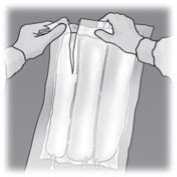
2.
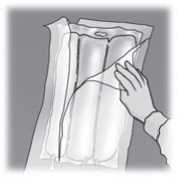
3.
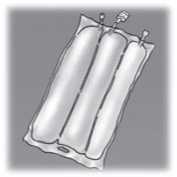
Tear from the top to open the overpouch.
Peel the front of the overpouch to reveal the TRIOMEL bag. Discard the overpouch and oxygen absorber sachet.
Place the bag flat on a horizontal and clean surface with the handle in front of you.
4.
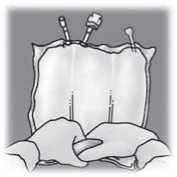
5.
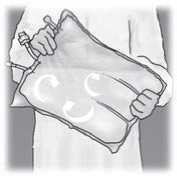
6.
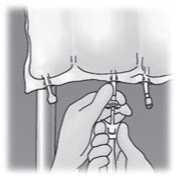
Mix by turning the bag upside-down at least 3 times.
Lift the hanger area to remove solution from the upper bag. Roll the upper part of the bag firmly until peal seals are fully open (approximately half way).
Hang the bag. Twist off the protector from the administration outlet. Firmly plug the spike connector.
BE3001 755
Administration
For single use only.
Only administer the product after the nonpermanent seals between the 3 compartments have been broken and the contents of the 3 compartments have been mixed.
Ensure that the final emulsion for infusion does not show any evidence of phase separation.
After opening the bag, the contents must be used immediately. The opened bag must never be stored for a subsequent infusion. Do not reconnect any partially used-bag.
Do not connect bags in series in order to avoid the possibility of air embolism due to gas contained in the primary bag.
Any unused product or waste material and all necessary devices must be discarded.
Extravasation
Catheter site should be monitored regularly to identify signs of extravasation.
If extravasation occurs, the administration should be stopped immediately, keeping the inserted catheter or cannula in place for immediate management of the patient. If possible, aspiration should be performed through the inserted catheter/cannula, in order to reduce the amount of fluid present in the tissues before removing the catheter/cannula.
Depending on the extravasated product (including the product(s) being mixed with TRIOMEL, if applicable) and the stage/extend of any injury, appropriate specific measures should be taken. Options for management may include non-pharmacologic, pharmacologic and/or surgical intervention. In case of large extravasation, plastic surgeon advice should be sought within the first 72 hours.
The extravasation site should be monitored at least every 4 hours during the 24 first hours, then once daily.
The infusion should not be restarted in the same central vein.
BE-30-01-755
12